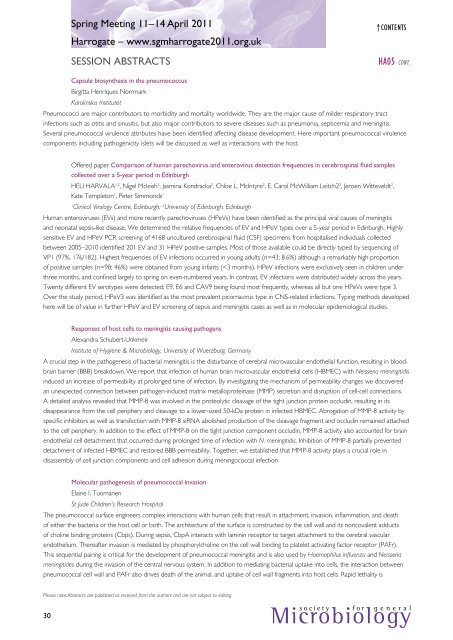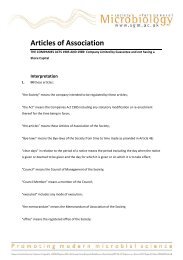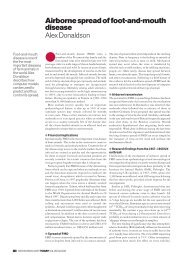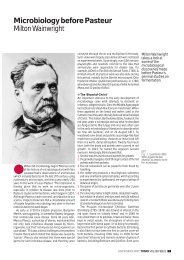Spring Conference 2011 - Society for General Microbiology
Spring Conference 2011 - Society for General Microbiology
Spring Conference 2011 - Society for General Microbiology
Create successful ePaper yourself
Turn your PDF publications into a flip-book with our unique Google optimized e-Paper software.
Please note: Abstracts are published as received from the authors and are not subject to editing.<br />
30<br />
<strong>Spring</strong> Meeting 11–14 April <strong>2011</strong><br />
Harrogate – www.sgmharrogate<strong>2011</strong>.org.uk<br />
SESSION AbSTrACTS<br />
↑Contents<br />
HA05 Cont.<br />
Capsule biosynthesis in the pneumococcus<br />
Birgitta Henriques Norrmark<br />
Karolinska Institutet<br />
Pneumococci are major contributors to morbidity and mortality worldwide. They are the major cause of milder respiratory tract<br />
infections such as otitis and sinusitis, but also major contributors to severe diseases such as pneumonia, septicemia and meningitis.<br />
Several pneumococcal virulence attributes have been identified affecting disease development. Here important pneumococcal virulence<br />
components including pathogenicity islets will be discussed as well as interactions with the host.<br />
Offered paper Comparison of human parechovirus and enterovirus detection frequencies in cerebrospinal fluid samples<br />
collected over a 5-year period in Edinburgh<br />
HEli HArVAlA1,2 , Nigel Mcleish2 , Jasmina Kondracka2 , Chloe l. Mcintyre2 , E. Carol McWilliam leitch22 , Jeroen Witteveldt2 ,<br />
Kate Templeton1 , Peter Simmonds1 1 2 Clinical Virology Centre, Edinburgh; University of Edinburgh, Edinburgh<br />
Human enteroviruses (EVs) and more recently parechoviruses (HPeVs) have been identified as the principal viral causes of meningitis<br />
and neonatal sepsis-like disease. We determined the relative frequencies of EV and HPeV types over a 5-year period in Edinburgh. Highly<br />
sensitive EV and HPeV PCr screening of 4168 uncultured cerebrospinal fluid (CSF) specimens from hospitalised individuals collected<br />
between 2005–2010 identified 201 EV and 31 HPeV positive samples. Most of those available could be directly typed by sequencing of<br />
VP1 (97%, 176/182). Highest frequencies of EV infections occurred in young adults (n=43; 8.6%) although a remarkably high proportion<br />
of positive samples (n=98; 46%) were obtained from young infants (
















